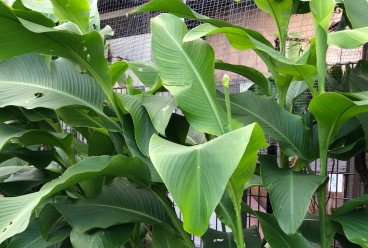Originally from South America, it is known as Qld Arrowroot because it was once a major industry in Queensland for the production of starch and flour. Starting in 1870, by 1892 there were 300 acres under production in Coomera and Pimpana, and by 1908 the region supplied the whole country. The industry died out because the crop was not big enough to be mechanised and it was uneconomic to harvest by hand.
Description: Hardy, clump-forming and heavily producing perennial up to 2m tall, shooting from a large red-skinned, round rhizome (tuber) often larger than a clasped fist. Lush bright green leaves. Spreads underground via rhizomes to form large clumps even in poor soils.
Uses:
Eat the tuber fresh, boiled, steamed, in stir fry, cakes
Young leaves shredded in stir fries or wrapping food
Used as a flour and thickener in cooking to produce a clear, thickened sauce, such as a fruit sauce.
Provides an excellent ongoing source of chop and drop mulch or can be used as a weed barrier and low garden windbreak.
Edible, living fence or planted alongside water on steep banks.
Leaves and tubers can be fed to chickens, goats, cows and donkeys
Plant next to the chicken coop to provide shade
Nutritional value:
Vitamins A, B1, B2, B3, B6, & C
High potassium content
1-3% protein (wheat flour has 10-12%)
The young leaves and shoots are nutritious and contain 10% protein
Gluten free flour
How to grow:
Will grow in any soil, including clay, but prefers loam with a neutral pH. A warm sunny position is ideal but will grow in full sun to partial shade. Hardy in drought and flooding and loves the wet season. Will go dormant in winter if not watered.
Propagation is through root division in spring, summer and early autumn. Dig up rhizomes from an established clump, split them apart into individual bulbs and replant. Rhizomes can be harvested after 4-6 months.
How to eat it:
Can be eaten raw, steamed, roasted, barbecued, diced finely, added to stir-fries, casseroles, stews, soups, in many meat or savory dishes.
Can be dried and ground into a powder and used as a flour and thickening agent
Looks and tastes similar to potato.
Takes longer to cook, yet holds its shape.
The tubers are best harvested to eat when still small, about the size of a tennis ball and the skin is still white. Young tubers have the best flavour; older ones are fibrous.
